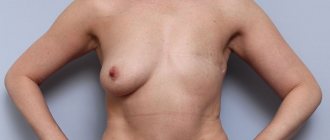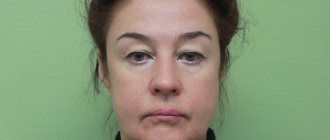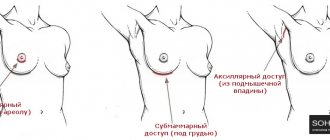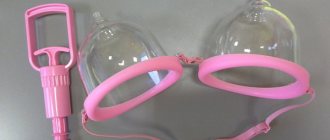In modern plastic surgery there are many different operations, such as abdominoplasty, liposuction of the abdomen, hips, arms and buttocks, face lifting, blepharoplasty of the eyelids, rhinoplasty of the nose, otoplasty of the ears, cruroplasty, correction of the chin or lips. But mammoplasty is especially popular, one type of which is mastopexy, that is, a female breast lift, which is just as popular as augmentation.
A lift can be performed in different ways, for example, vertical or anchor. But periareolar mastopexy of the female breast is considered the least traumatic and practically leaves no scars. Learn more about it from this article to get answers to your questions and find useful information of interest.
What is periareolar mastopexy?
Periareolar breast lift – what is it?
This is a plastic surgery, the main purpose of which is to tighten the mammary gland, that is, to remove its excess skin. With this type of surgery, excess skin around the areola is removed. Sometimes breast augmentation is performed with implants.
According to reviews from surgeons and women who have undergone this type of mammoplasty, this procedure is less traumatic and more gentle compared to other types of mastopexy, including vertical and anchor. But such a breast lift is not indicated in all cases and can solve only some problems.
For your information!
A halo cut is a mistaken spelling, since a halo is a border that surrounds an object. Oral mastopexy is also a mistake because oral is a way of taking medications through the mouth. These concepts have nothing to do with plastic surgery and cosmetology.
Periareolar mammoplasty is performed using two methods that differ in surgical approaches:
- Circular mastopexy. With this, two circular incisions are formed. The first is done along the contour of the areola of the breast, and the second is indented from the nipple-areolar complex. In fact, a ring-shaped flap of skin is removed. Next, the edges are stitched and the skin is tightened.
- Mastopexy with crescent-shaped approach. With this technique, a section of excess skin in the shape of a crescent or half a ring is excised from the chest. The doctor makes one incision in a semicircle, usually along the lower contour of the areola (it is in the area of the lower pole of the breast that there is usually excess skin). The second cut is formed lower, indented from the first. Then the edges are also sewn together.
The first option is the most preferred and in demand, according to reviews. Circular mastopexy allows you to remove excess skin around the entire circumference of the areola, and simultaneous breast augmentation is also possible. With the second technique, only a segment in the lower part is excised. This method is relevant if the excess skin is localized precisely in the lower region of the mammary gland, and not in the upper, and at the same time the nipple-areolar complex has a normal and physiologically correct position without significant ptosis or is located high on the chest.
Complications of areolar breast lift
The development of mastopexy was initially marked by techniques that sought to achieve good shape and projection of the mammary glands and resulted in large scars (Strombeck techniques 1960; Pitanguy 1960). Later, mastopexy techniques with gradually decreasing scars appeared, such as “L”, vertical and, finally, periareolar.
Initially, the periareolar method often led to skin necrosis, as the subcutaneous choroid plexus was damaged. Subsequently, this was understood and eliminated, and periareolar mastopexy became a safe method.
Complications such as increased areola diameter and early secondary ptosis are corrected using a periareolar suture block (Benelli suture) and resection of the gland parenchyma during the primary operation. In the technique presented here, resection of the upper pole in a “V” shape and fixation of the gland to the pectoralis major muscle provides good breast projection and stabilizes the result in the medium to long term.
Observed folds of skin around the areola usually smooth out after 2-5 months. after operation. In case of large resections, it is sometimes necessary to perform correction of the periareolar scar 7-12 months after surgery.
It is also possible to develop general surgical complications, for example, hematomas, seromas, sensory disturbances, necrosis, etc. But knowledge and adherence to the surgical technique, implementation of certain preventive measures during and after surgery, and compliance with recommendations by the patient in the postoperative period reduce the risk of complications to zero.
In what cases is periareolar mastopexy indicated?
Circular breast lift has the following indications:
- ptosis, if the degree of breast ptosis is insignificant;
- false ptosis, in which there is sagging in the lower part of the mammary gland, but the nipple and areola are positioned correctly;
- tubular, pointed, elongated or elongated form of the mammary glands;
- gynecomastia detected in men;
- the impossibility or reluctance of a woman to use implants for breast lift.
For your information!
If it is necessary to reduce the mammary glands due to their impressive size, then another operation is indicated - reduction mammoplasty.
Anchor mastopexy
With anchor mastopexy, the incision can be made in two ways.
In the first case, a horizontal incision along the inframammary fold is added to the incision used for vertical mastopexy.
The second uses the “anchor” method. The incision line runs around the areola and along the inframammary fold. They are connected by almost vertical cuts. The scar subsequently has the shape of an anchor.
The procedure lasts about three hours and has a long rehabilitation period.
Often anchor mastopexy is combined with reduction mammoplasty.
The operation is indicated for:
- third degree ptosis
- fourth degree ptosis
- pseudoptosis
- severe breast changes
All the advantages and disadvantages
Periareolar mammoplasty, like any other plastic surgery, has its pros and cons. Let's start by analyzing its advantages:
- Excellent aesthetic results. Periareolar breast lift really makes the breasts more toned and attractive, allowing for shape correction.
- No significant or highly visible scars. The stitches are formed along the contour of the areola, so scars on the chest will be practically invisible.
- Low morbidity. The area where the skin is stitched is not very large, and the soft tissues are minimally affected (they are not removed, since surgical breast reduction is not performed).
- Possibility of combination with breast augmentation. If there is insufficient volume of glandular and fatty tissue, a periareolar breast lift may well be combined with the installation of implants or with lipofilling - the introduction of one’s own fatty tissue taken from the most voluminous parts of the body.
- Simpler and shorter recovery period. Rehabilitation actually proceeds in most cases without complications or undesirable consequences.
- Possibility of simultaneous correction of existing asymmetry of the nipples, areolas or mammary glands. An experienced surgeon can carefully calculate the diameter of the excision area and select the optimal configuration of incisions to make the two breasts identical and as symmetrical as possible.
Let's look at the disadvantages:
- The impossibility of simultaneously performing female breast reduction with excision of soft tissue. In periareolar mastopexy, only excess skin is removed. Reduction is required in case of excess amounts of glandular and fatty elements.
- When performing breast augmentation surgery, in addition to a circular incision along the contour of the areola, the surgeon must also make access into the mammary gland itself to form a pocket. And such manipulations injure tissues and also increase the risk of infection by expanding the damaged open area. In addition, when reducing the volume of skin and simultaneously installing an implant, sutures may come apart during the postoperative period.
- When a significant amount of skin is excised, the shape of the mammary gland is likely to flatten, especially if the patient has small reserves of her own fatty and glandular tissue. In this case, a woman may decide to have breast augmentation.
- There is a high risk of divergence of sutures with large volumes of female breasts or after breast augmentation performed with implants.
- It is impossible to eliminate pronounced mastoptosis with this plastic surgery, in which the lower pole of the mammary gland is located much lower than the level of the inframammary (submammary) fold.
What should you know about mastopexy?
Periareolar breast lift is indicated for patients in the following situations:
- after breastfeeding, excess skin volume has formed as the glandular tissue has sharply decreased in size;
- due to sudden weight loss, ptosis of the mammary glands has formed, which cannot be eliminated with special creams aimed at improving skin elasticity;
- a woman does not accept the use of silicone implants to correct the shape of her breasts, and ptosis of the mammary glands causes psychological discomfort;
- The mammary glands began to lose their natural shape due to the force of gravity and the lost elasticity of the skin due to the woman’s age.
Circular mastopexy has no medical indications, but is recommended to patients for the purpose of aesthetic correction of the shape of the mammary glands.
When surgery is contraindicated
Circular breast lift, like other types of breast surgery (including breast augmentation), has the following contraindications:
- the patient planning pregnancy in the near future;
- period of bearing a child;
- completion of lactation less than a year ago;
- blood clotting disorders;
- diabetes;
- acute inflammatory processes;
- exacerbation of chronic diseases;
- ARVI (treatment required);
- diagnosed oncology;
- severe diseases of the heart, blood vessels, respiratory system (decompensated stages);
- severe infections: diphtheria, typhoid, hepatitis and others;
- the presence of foci of inflammation in the area of surgical access formation;
- fibrocystic mastopathy;
- neoplasms of unknown origin.
Contraindications must be fully identified during the initial consultation and during diagnosis.
Indications and contraindications
The main indication for a breast lift is a woman’s dissatisfaction with the aesthetic appearance of her mammary glands.
- Indications:
- breast ptosis of varying degrees (the nipple is lowered below the level of the inframammary fold);
- asymmetry of the mammary glands.
Contraindications for breast lift are the same as for any mammoplasty.
- Contraindications:
- uncompensated diabetes mellitus;
- the presence of acute inflammatory diseases;
- pathology of blood clotting;
- diseases of the cardiovascular system;
- predisposition to the formation of keloid scars.
How to prepare for a periareolar lift
Periareolar breast lift requires certain preparation, which includes examination and compliance with certain rules. First of all, the surgeon conducts a face-to-face consultation: at the initial appointment, he answers the woman’s questions, assesses the condition of the breast and decides whether mastopexy will give the desired effect.
Further, after consultation and the doctor’s decision to perform periareolar lift surgery, during the diagnosis the patient undergoes general and biochemical blood tests, and a urine test. Some diagnostic procedures are performed: ultrasound of the mammary glands, angiography of the vessels of the lower extremities, ECG and fluorography. If necessary, examinations by specialized specialists, for example, a cardiologist, oncologist, gynecologist, or surgeon, are possible.
The rules for preparing for breast lift surgery performed in the periareolar manner are as follows:
- Two weeks before the operation, you should completely stop taking any medications that affect the blood coagulation system. These are non-steroidal anti-inflammatory drugs (including aspirin), oral contraceptives, vitamin E and anticoagulant medications.
- A week before the day of breast surgery, a woman gives up smoking cigarettes and drinking alcohol, eats a balanced and healthy diet.
- The day before your breast lift date, you should take a shower or bath.
- 12 hours before the start of the operation, stop eating food and any liquids.
The surgeon will give detailed recommendations regarding preparation for plastic surgery during the consultation.
First stage of intervention
- The operation is considered technically complex and requires the doctor to have qualifications and experience in this area. The technique is effective in cases where the breasts have lost their attractiveness due to sagging after childbirth and breastfeeding, after a sharp weight loss, as a result of age-related changes. Ptosis is also possible in women with large breasts. The doctor identifies these signs during the initial consultation. Laboratory tests are then prescribed.
- Next, the surgeon sets a date for the operation. Surgery takes place in the clinic with hospitalization for 1-2 days. On the appointed day, the woman must come to the clinic, always on an empty stomach, since the operation will be performed on the same day. The doctor conducts a follow-up examination and marks the glands before surgery. At the same stage, the test results are assessed and possible contraindications are determined. A visit to an anesthesiologist is required. Based on the results of laboratory tests, he will be able to select drugs used in anesthesia, as well as calculate their dosage.
- After this, premedication is carried out. By choosing sedatives, it is possible to relieve tension and reduce possible stress before surgery. Antibiotics can also be used at the preparatory stage. This has been proven to help reduce the risk of complications after surgery to zero. Only after this the woman is sent to the operating room.
How will the operation take place?
Circular mastopexy by a surgeon is performed in several stages:
- The anesthesiologist administers general anesthesia, the type of which is pre-selected taking into account the patient’s health condition.
- The area where the surgical access is formed is disinfected - treated with an antiseptic solution.
- The surgeon applies markings - lines along which the incisions will be formed during the lift. They surround the areola, passing along its contour and a little further.
- The skin is excised along the marked lines. The resulting skin ring is completely removed.
- If you plan to undergo breast augmentation, a pocket is created for subsequent placement of the implant.
- The flap of skin remaining outside the nipple and areola is pulled to the nipple-areolar complex and sutured to its edge in a circle. As a rule, when lifting breasts through the periareolar approach, surgeons use two types of threads: absorbable, applied to soft tissue, and thin nylon to connect the skin. This approach minimizes the risk of sutures coming apart.
- Next, the seams are treated with an antiseptic.
- A bandage is made.
- The patient recovers from anesthesia and is temporarily transferred from the operating room to the intensive care ward, and then to the general ward.
As a rule, the entire operation lasts about 1-1.5 hours, with an increase a little longer.
Correction of areolas and nipples
Breast lift surgery is often performed with simultaneous correction of the shape of the breast and correction of the nipple-areolar complex.
However, correction of areolas and nipples is often performed as an independent operation. This procedure gives a woman the opportunity to quickly and effectively get rid of imperfections that have bothered her all her life (anomalies in the development of the nipples, sloppy appearance of the areolas, excessive or absent pigmentation of this area, etc.).
Indications for correction of the shape of nipples and areolas:
• retraction or flattening of the nipple;
• excessive nipple protrusion;
• underdevelopment or absence of the nipple;
• violation of the symmetry of areolas and nipples;
• unaesthetic appearance of the areola (disproportionately large or small pigment circle, uneven or dark color).
Manipulations with the nipple-areolar complex can be performed under local or combined anesthesia (if simultaneous intervention, including endoprosthetics or breast lift, is not planned). The operation takes on average about 1 hour.
Important! Since not all methods guarantee unhindered breastfeeding in the future, it is necessary to carefully and comprehensively discuss this issue with the surgeon and assess the risks.
We list the most popular surgeries to correct areolas and nipples:
Correction of nipple shape (nipple reduction). During the operation, excess nipple tissue is excised, then a cosmetic suture is placed on the nipple.
Correction of inverted nipples. The operating doctor makes an incision at the base of the nipple, separates the structures that pull it inward, then secures the nipple in the proper position, preventing it from relapsing.
Reduction of nipple areolas. The surgeon excises excess skin along the edge of the areola, forms the boundaries of the new areola, then applies internal and external (cosmetic) sutures. The areola circumference can be reduced by 3-4 cm.
Enlargement of nipple areolas. This is an aesthetic manipulation used to correct unexpressed, absent or weakly pigmented areolas, as well as their asymmetry. A pigment is injected into a pre-marked area of skin that imitates the natural color of the areolas.
After the operation, the patient also remains in the hospital for some time, then is sent home. For speedy rehabilitation and consolidation of the result, you should wear supportive underwear made of special knitwear and follow the doctor’s instructions.
Breast lift with correction of areolas and nipples. Photos before and after surgery.
1 Photo before breast lift with correction of areolas and nipples
2 Photos after a breast lift with correction of areolas and nipples
3 Photos after a breast lift with correction of areolas and nipples
If you dream of improving something in your appearance, for example, resorting to a breast lift or correction of the nipple-areolar area, make your decision consciously! Study professional medical articles and reviews about breast lift, visit the clinics you like, and personally consult with doctors. Your decision about breast surgery should be balanced!
Be sure to visit the MedicCity multidisciplinary clinic. Our plastic surgeons have impressive practical experience and are proficient in all classical and innovative methods of breast correction!
Rehabilitation after plastic surgery
Recovery is usually uncomplicated and occurs relatively quickly, but requires compliance with the recommendations given by the plastic surgeon. During the day, the woman remains in the clinic under the supervision of medical personnel, then, if there are no identified complications, she is sent home.
At first, the bandages are changed, painkillers may be prescribed for severe pain and antibiotics to prevent infection. Until the sutures are removed and examined by a surgeon after a lift, water should not be allowed to get into areas of developing scars.
Be sure to follow these recommendations:
- For the first two weeks, you should not raise your arms, or sleep on your stomach or side.
- For one to two months, visiting saunas, public reservoirs, baths and solariums is prohibited.
- It is also necessary to wear compression garments. It is not removed for the first six weeks, and then put on before physical activity. The length of the wearing period depends on the speed of healing and the characteristics of the lift. Thus, when installing implants, underwear is used longer due to the risk of ruptures in the forming scars.
- For some time (one to two months), physical activity is prohibited.
Rehabilitation period
Complete rehabilitation after mastopexy lasts from six months to one and a half years. After the operation, the patient remains in the clinic for at least one day. Round-the-clock medical supervision, dressings, and analysis of recommendations during the recovery period help to avoid complications after mastopexy. Minor pain may last for three days. A month after mastopexy there will be swelling in the breast area - this is a normal reaction of the body.
The patient should wear compression garments for at least one and a half months. Compression garments after mastopexy allow you to fully preserve the result of plastic surgery, prevent stretching and divergence of postoperative scars, reduce the severity of pain and reliably fix the implants. Sutures after mastopexy and their quality are of great importance for the result of the operation: the quality of the future scar depends on the skills of the doctor and the patient’s careful handling of them during the recovery period.
Restrictions during the rehabilitation period include lifting weights up to 3 kg and physical activity. Warming procedures should also be excluded: bathhouse, sauna, solarium. The clinic will give you a reminder: be sure to follow your surgeon’s recommendations. How much does a mastopexy cost?
A breast lift is a complex, labor-intensive operation that requires a doctor to have a lot of experience and special skills - such a surgical correction cannot be cheap. The cost of an operation in our surgical center is 240,000 rubles. General anesthesia, hospitalization and compression garments are paid separately.
Prices
How much does a circular breast lift cost?
| Clinic "Osnova" | from |
| Periareolar breast lift (mastopexy) | 130 000 ₽ |
| Breast lipofilling up to 600 ml. (1 category) | 180 000 ₽ |
| Vertical breast lift (mastopexy) | 190 000 ₽ |
| Breast augmentation with SILIMED round implants | 210 000 ₽ |
| Breast reduction | 210 000 ₽ |
| Implant lift with periareolar mastopexy | 210 000 ₽ |
| Breast lipofilling from 600 ml. (category 2) | 210 000 ₽ |
| Breast augmentation with anatomically shaped SILIMED implants | 230 000 ₽ |
| Tubular breast correction with SILIMED implants | 260 000 ₽ |
| T-shaped breast lift (mastopexy) | 280 000 ₽ |
| Breast surgery after mastectomy | 340 000 ₽ |
Prices for periareolar mastopexy in Moscow and other cities depend on many factors:
- a specific clinic (it must have the necessary licenses) and its policies;
- features of breast lift (conventional periareolar plastic surgery or correction with nipple enlargement and correction, for example);
- qualifications and experience of the surgeon who will perform the lift;
- conditions of the offer (which is included in the cost of the correction).
To find out the preliminary cost or exact price, you can check this information on the website, call the clinic by phone, or make an appointment for a consultation.
Types of mastopexy
The development of technology and the improvement of surgical techniques have allowed modern surgeons to approach the breast lift procedure as individually as possible.
After a consultation and examination, the doctor chooses the type of intervention taking into account the information received.
Depending on the degree of ptosis and the characteristics of your body, he may offer the following types of mastopexy:
- periareolar (circular)
- vertical
- anchor (T-shaped cut)
- dermal
- endoscopic
I'll tell you briefly about each.
End of operation
After the operation is completed, sutures and a sterile bandage are applied in layers. Compression garments are also required. It will have to be worn for a month after the intervention. Immediately after the operation is completed, the anesthesiologist removes the patient from anesthesia, monitoring her condition. Then, for several hours, she is under constant supervision of doctors in the intensive care unit and only after stabilization of her condition and all parameters is transferred to the ward. She will stay there for 1-2 days. During this period, severe pain is possible, so the patient is given strong painkillers. On the second day, dressing is performed. The surgeon assesses the condition of the tissues, the severity of swelling, pain, and the presence of hematomas. The very next day, the doctor may allow the woman to be discharged and go home. She will be visiting the clinic for dressing changes and monitoring over the next few weeks.
Postoperative period
The early postoperative period takes place in the hospital. In this case, the woman must strictly follow all the doctor’s instructions. Compression garments are removed only during the examination. She will have to stay in it day and night. Pain is normal, so there is no need to panic either. After discharge, the doctor will prescribe painkillers that the woman can take at home.
The recovery period lasts up to four months. At first, in addition to painkillers, antibiotics may be prescribed. The first 3–4 dressing changes are performed by a surgeon in the clinic. Next, the woman will do the procedure at home herself. For any abnormalities, swelling, or redness, you should consult a doctor.










